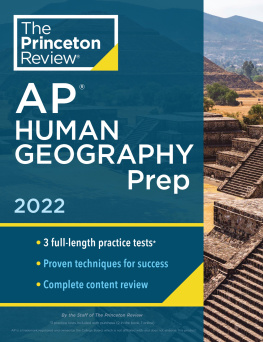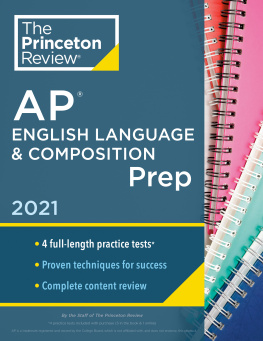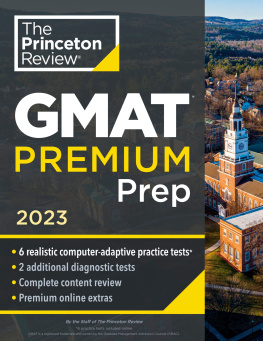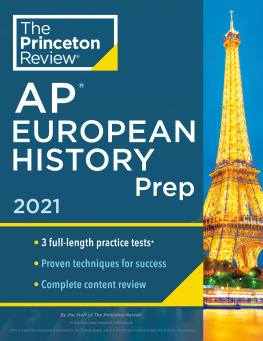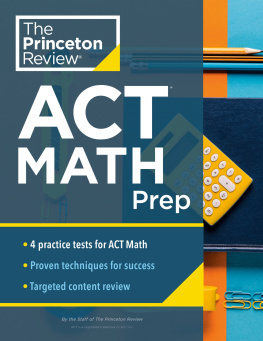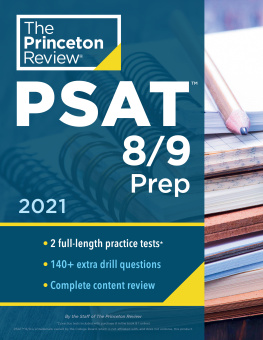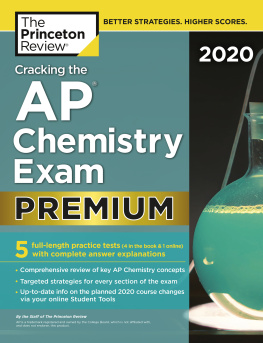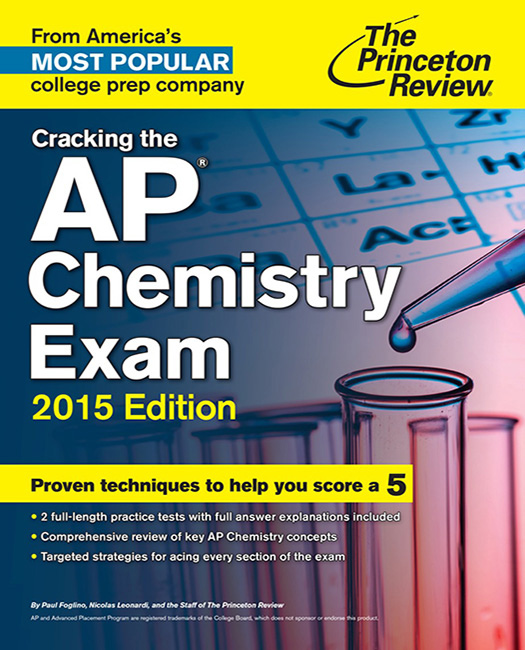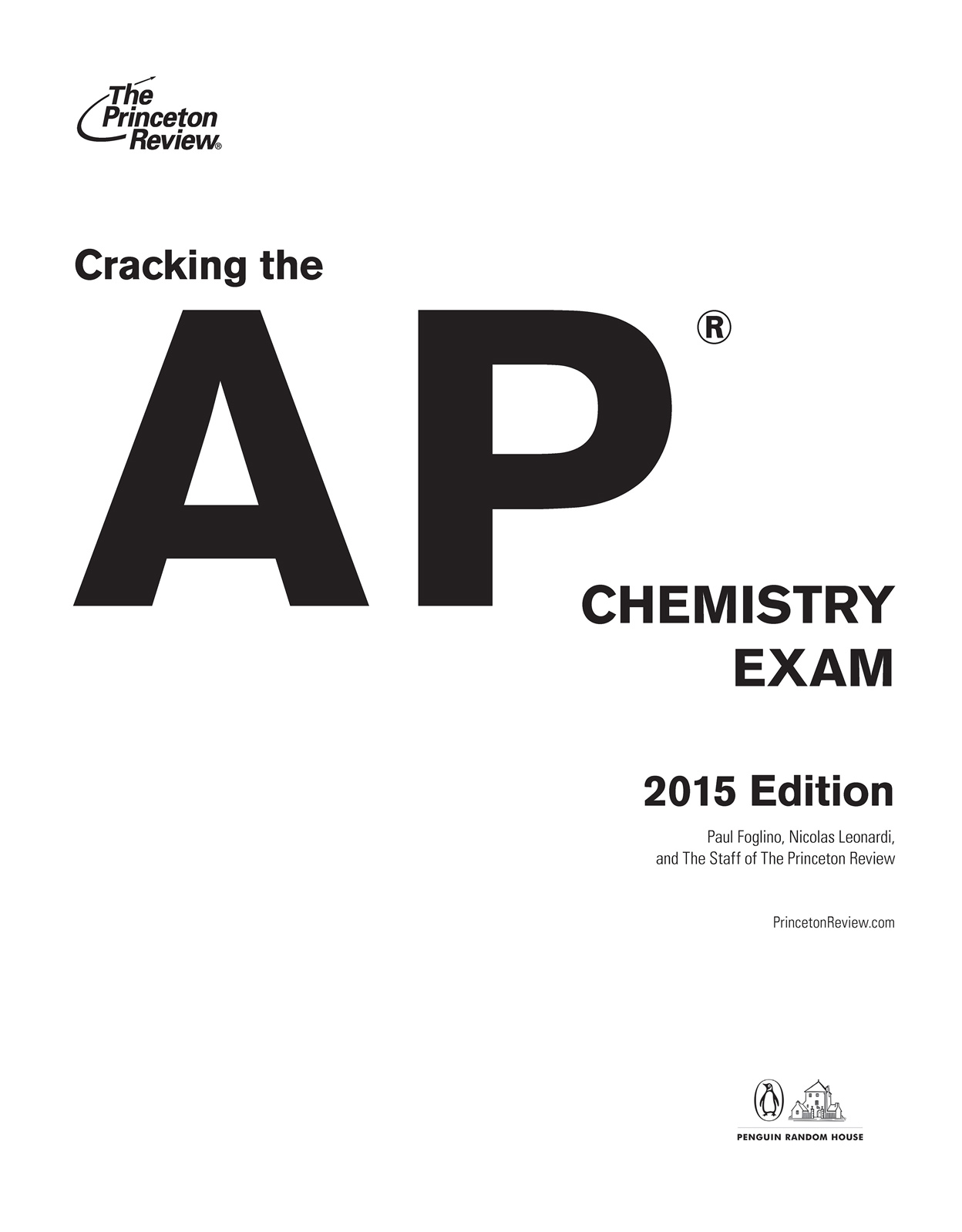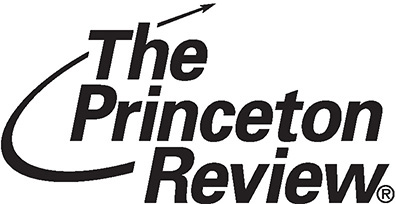

Editorial
Rob Franek, Senior VP, Publisher
Casey Cornelius, VP Content Development
Mary Beth Garrick, Director of Production
Selena Coppock, Managing Editor
Calvin Cato, Editor
Colleen Day, Editor
Aaron Riccio, Editor
Meave Shelton, Editor
Orion McBean, Editorial Assistant
Random House Publishing Team
Tom Russell, Publisher
Alison Stoltzfus, Publishing Manager
Melinda Ackell, Associate Managing Editor
Ellen Reed, Production Manager
Kristin Lindner, Production Supervisor
Andrea Lau, Designer
The Princeton Review, Inc.
24 Prime Parkway, Suite 201
Natick, MA 01760
E-mail:
Copyright 2014 by TPR Education IP Holdings, LLC. All rights reserved.
Cover art laboratory/Alamy
Published in the United States by Random House LLC, New York, and
simultaneously in Canada by Random House of Canada Limited, Toronto.
A Penguin Random House Company.
eBook ISBN: 978-0-8041-2513-0
Trade Paperback ISBN: 978-0-8041-2512-3
AP and Advanced Placement Program are registered trademarks of the
College Board, which does not sponsor or endorse this product.
The Princeton Review is not affiliated with Princeton University.
Editor: Calvin S. Cato
Production Editor: Jesse Newkirk
Production Artist: Deborah Silvestrini
2015 Edition
v3.1
Acknowledgments
Paul Foglino would like to thank John Katzman for his oversight on this project and Rebecca Lessem for her work editing the first edition of this title. Thanks to Rachel Warren, whose guidance and tireless effort helped to convert chemistry to English. Thanks to Eric Payne for his rigorous attention to detail. Thanks to Tom Meltzer for his advice and Libby OConnor for her patience. Additional thanks are in order to Robbie Korin, James Karb, and Chris Volpe.
The Princeton Review would like to give special thanks to Nicolas Leonardi for his hand in revising and updating this title to better prepare students for the new AP Chemistry exam.
Contents
Part I
Using This Book to Improve Your AP Score
PREVIEW ACTIVITY: YOUR KNOWLEDGE, YOUR EXPECTATIONS
Your route to a high score on the AP Chemistry Exam depends a lot on how you plan to use this book. Please respond to the following questions.
1. Rate your level of confidence about your knowledge of the content tested by the Chemistry AP Exam:
A. Very confidentI know it all
B. Im pretty confident, but there are topics for which I could use help
C. Not confidentI need quite a bit of support
D. Im not sure
2. Circle your goal score for the AP Chemistry Exam.
3. What do you expect to learn from this book? Circle all that apply to you.
A. A general overview of the test and what to expect
B. Strategies for how to approach the test
C. The content tested by this exam
D. Im not sure yet
YOUR GUIDE TO USING THIS BOOK
This book is organized to provide as muchor as littlesupport as you need, so you can use this book in whatever way will be most helpful to improving your score on the AP Chemistry Exam.
- The remainder of Part I will provide guidance on how to use this book and help you determine your strengths and weaknesses
- of this book will
- provide information about the structure, scoring, and content of the Chemistry Exam
- help you to make a study plan
- point you towards additional resources
- of this book will explore
- how to attack multiple-choice questions
- how to write high-scoring free-response answers
- how to manage your time to maximize the number of points available to you
- of this book covers the content you need for your exam.
- of this book contains practice tests.
You may choose to use some parts of this book over others, or you may work through the entire book. This will depend on your needs and how much time you have. Lets now look how to make this determination.
HOW TO BEGIN
Take a Test
Before you can decide how to use this book, you need to take a practice test. Doing so will give you insight into your strengths and weaknesses, and the test will also help you make an effective study plan. If youre feeling test-phobic, remind yourself that a practice test is a tool for diagnosing yourselfits not how well you do that matters but how you use information gleaned from your performance to guide your preparation.
So, before you read further, take AP Chemistry Practice Test 1 starting at of this book. Be sure to do so in one sitting, following the instructions that appear before the test.
Check Your Answers
Using the answer key on , count how many multiple-choice questions you got right and how many you missed. Dont worry about the explanations for now, and dont worry about why you missed questions. Well get to that soon.
Reflect on the Test
After you take your first test, respond to the following questions:
- How much time did you spend on the multiple-choice questions?
- How much time did you spend on each long form free-response question? What about each short form free-response question?
- How many multiple-choice questions did you miss?
- Do you feel you had the knowledge to address the subject matter of the free-response questions?
- Do you feel you wrote well organized, thoughtful answers to the free-response questions?
- Circle the content areas that were most challenging for you and draw a line through the ones in which you felt confident/did well.
- Big Idea #1: Atoms, Elements, and the Building Blocks of Matter
- Big Idea #2: Chemical and Physical Properties of Matter
- Big Idea #3: Chemical Reactions, Energy Changes, and Redox Reactions
- Big Idea #4: Chemical Reactions and their Rates
- Big Idea #5: Laws of Thermodynamics and Changes in Matter
- Big Idea #6: Equilibrium, Acids and Bases, Titrations and Solubility
Read of this Book and Complete the Self-Evaluation
As discussed previously, Part II will provide information on how the test is structured and scored. As you read Part II, re-evaluate your answers to the questions on the previous page. You will then be able to make a study plan, based on your needs and time available, that will allow you to use this book most effectively.


